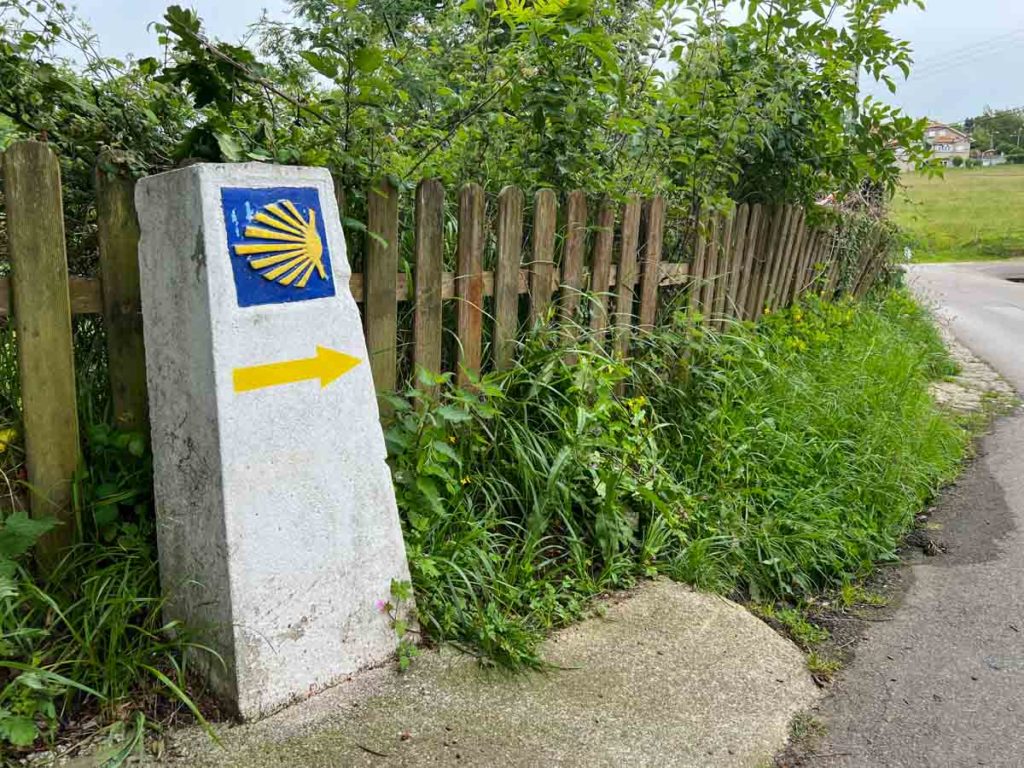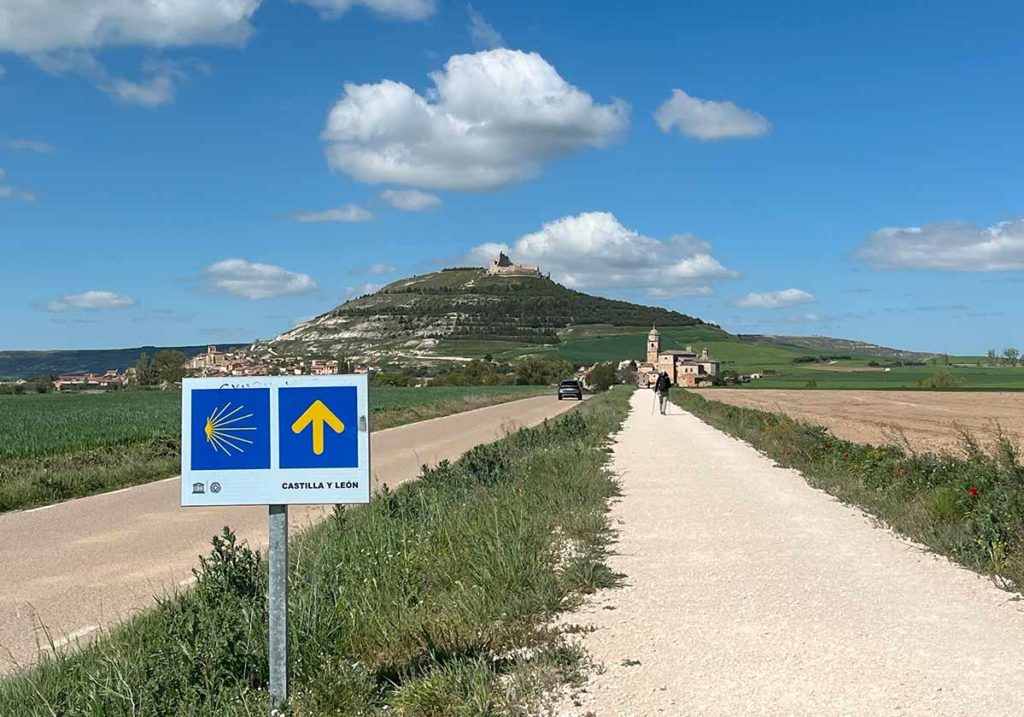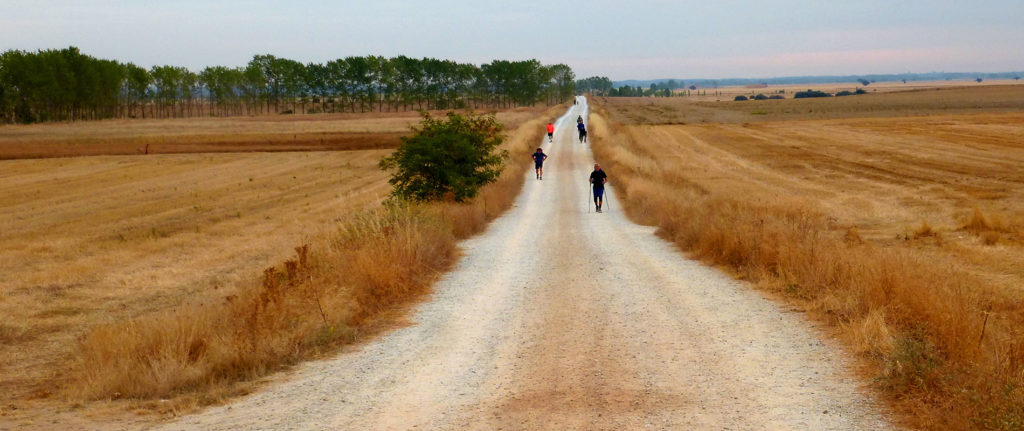Prepare for Your Camino
Are you planning to do the Camino de Santiago? Congratulations! Part of our mission is to provide information that helps pilgrims find inspiration, plan and execute their pilgrimage.
The purpose of this page is to help you plan your Camino. Below you’ll find information to help you choose a route, expectations around timing and distances, guidebook options, guidance on training and how to obtain your pilgrim credential.
Once you’ve planned your route and timing, be sure to check out our “what to expect on the Camino” FAQ. That page covers topics like what to pack, how accommodations work, getting mobile access, food and other on-the-ground info.

Camino Planning Table of Contents
- About the Camino
- How to choose a Camino route
- Determining how far you can walk
- Tour providers vs. a DIY Camino
- How to budget for the Camino
- What is a Compostela?
- What is a credential?
- When to do the Camino
- Can you bike the Camino?
- Training tips
- Choosing a guidebook or app
- How to get to your starting point
- Do you need a visa?
- Do you need travel insurance?
- More resources
Here’s your FAQ on how to plan your Camino:
About the Camino de Santiago
What is the Camino de Santiago?
The Camino de Santiago (the Way of St. James) is a large network of ancient pilgrim routes stretching across Europe and coming together at the tomb of St. James in Santiago de Compostela. Santiago de Compostela is located in the region of Galicia, in northwestern Spain.
If you’d like more history on this thousand-year-old pilgrimage route, check out our history page.
How Many People Walk the Camino Every Year?
In 2019, 347,578 people received a Compostela. Both 2020 and 2021 were unusual years for the Camino due to COVID-19. In 2024, 499,000 people received a Compostela
These numbers don’t include people who arrive in Santiago but don’t request a Compostela, nor people who walk various parts of the Camino and never arrive in Santiago at all. The total number might be double those cited.
If you’re into numbers, check out our Camino stats page.
Is there more than one Camino de Santiago?
The Camino Francés is the most traveled route and a popular one for first-time pilgrims, but there are additional routes throughout Spain and all of Europe. Historically, pilgrims walked out their front door and walked until they reached Santiago and then walked home.
How Do I Choose a Route for the Camino?
The most popular route by far is the Camino Francés, particularly for first-time pilgrims. But there is a constellation of routes that end in Santiago. We have loads of information on starting/ending points and distances for all of the major (and even some of the lesser-known) Camino routes.
Your starting and ending points on your selected route will depend on your answers to three principal questions:
How long do you have to walk?
This question matters only if you have a set amount of time for walking. If you want to do a full route in that time, you’ll need to choose one of the appropriate distance. Keep in mind any of the routes to Santiago can be done in sections over time (even over several years).
Is it important for you to arrive in Santiago?
For many pilgrims arriving in Santiago is an important part of their spiritual and physical journey. If this is the case for you, then choose a route that will end there. Determine how many days you have for walking and work backward from Santiago to determine your starting point.
Do You wish to receive a Compostela?
If so, the Pilgrim Office in Santiago has specific requirements. We summarize them lower on the page.
I Only Have So Much Time, How Far Can I Walk?
This is a difficult question to answer as it depends greatly upon your personal fitness and how much time you’d like to spend exploring the Camino’s many cathedrals, museums and historical sites. You may also be affected by weather, or the pacing of the friends that you meet along the Way.
If you’re wondering how long it will take to do the Camino, you’ll need to consider you personal pacing and how many rest days you want.
Most people walk between 20-30 kilometers (12.5-18.5 miles) per day. If you have two weeks on the ground, you should be able to cover 280-378 kilometers (174-234 miles). If you walk a longer route, such as the full 790-kilometer Camino Francés, you may want to plan for some rest days, or at least a few shorter days.

Camino Tour Providers vs. Doing it DIY
Some pilgrims chose to carry their own packs, staying in albergues and planning it all themselves. Others prefer to convenience or comfort of a tour provider with pre-booked private rooms and luggage portaging. If you are on the fence about which way to go, here are some pros and cons for each approach.
Camino Tour Providers
- Pros: Covers the logistical hassle of figuring out where to stay. Usually includes private rooms in hotels, guesthouses or private albergues. Covers luggage portaging. And if a group tour, usually provides a support vehicle.
- Cons: Far more expensive than the DIY option. Locks you into pre-set stages, giving you little flexibility for rest days, injury recuperation or a simple change of plan. Some accommodations are off-trail, requiring extra kilometers of walking or a transport.
DIY
- Pros: The ultimate flexibility for where and how long you walk each day. Ability to change your plan on the fly. Opportunity to participate in albergue group dinners. Can chose a variety of accommodation, depending upon your needs and budget.
- Cons: Effort spent on managing daily accommodation logistics and uncertainty of a bed during busy periods.
How Much Does the Camino Cost?
This depends greatly upon your choice of accommodation and whether you’ll do restaurant meals or your own cooking. The following ranges are exclusive of the cost of getting to your start point and from your end point.
Budget: €45-50 per day. This assumes that you’ll bunk primarily in the lower cost municipal albergues, carry your own lunch supplies and have low-cost restaurant pilgrim meals or do your own cooking in the evening.
Mid-range: €50-55 per day. This assumes a mix of public and private albergues, usually in the group rooms, with an occasional splurge stay or private room, you eat out most meals, but occasionally eat in or carry your lunch.
High-end: €75-80 per day. This assumes that you stay primarily in private rooms in private albergues, guesthouses or hotels, and you want to spent more on a nice evening meal. If you choose to use a travel provider to book the trip for you, it will be much higher.
Plan some buffer budget for trips to the pharmacy, museum entrances, taxi or bus fees if you chose to skip ahead, and any gear that you need along the way.
If you want to use a luggage portage service, add €7-10 per day.
What is a Compostela?
The Compostela is a certificate provided by the Cathedral certifying the completion of one’s pilgrimage to Santiago de Compostela. But for most pilgrims, it signifies much more than that. It serves as a symbol of their spirituality, devotion or personal growth, and it’s a reminder of their achievement.
The requirements to qualify for a Compostela changed in 2025. For more information refer to Santiago de Compostela Pilgrim’s Reception Office.
Here’s our summary of the requirements for obtaining a Compostela:
- You must do at least 100 kilometers on foot or horseback, or 200 kilometers by bike
- …on the same route
- …which is an official route recognized by the Pilgrim’s Reception Office
- …and the final stage must be one that leads to the Santiago Cathedral
- You can do your Camino in stages, provided that they are in chronological and geographical order.
- You must collect sellos (stamps) along the way in your credential. For the 100/k minimum requirement, all pilgrims, regardless of starting point, need to collect at least two stamps per day, one at the beginning and one at the end of the stage.
- You must make the pilgrimage for religious or spiritual reasons.
We have an article that spells this out in further detail and gives advice on how to claim your Compostela in Santiago.
What is a Credential?
While walking the Camino de Santiago, pilgrims carry a credential, a small document in which the pilgrim records his or her progress by obtaining stamps along the way. Stamps can be obtained from many sources including bars, cafes, hotels, town halls, museums and churches, and from all albergues and most other lodgings.
When registering at an albergue, you will be asked to present your credential to verify you are a pilgrim. Upon arrival in Santiago de Compostela, you present your credential at the Pilgrim’s Office. They’ll confirm you’ve met the requirements for a Compostela.
Pilgrim credentials can be obtained before setting out on the Camino – from us, or from locations such as cathedrals, albergues and tourism offices along the various Camino routes.
You can request a credential from American Pilgrims, the only provider of credentials in the United States authorized by the Pilgrim’s Office in Santiago de Compostela.
What Time of Year Should I Go?
Spain and Portugal have a moderate, Mediterranean climate, not unlike California. They typically have warm-to-hot summers and cool winters. The region of Galicia, where Santiago de Compostela is located, is known for its rainy weather year-round. Some of the higher elevations, particularly right out of St. Jean on the Camino Francés, get snow. The Camino Weather site will give you weather averages for various routes.
April through October are good times to do the Camino for the best weather and it’s also when the most number of albergues are open. Early May to mid-September are the busiest times. If you like winter walking, be aware that you will have fewer lodging choices.
When you pack for the Camino, assume a mix of warm/hot days, cool mornings and at least some days with rain.
Can I Bike the Camino?
Yes! About 5% of pilgrims who arrive in Santiago do so by bicycle. Cyclists are eligible to receive a Compostela if they document they have ridden the final 200 kilometers to Santiago, essentially from Ponferrada on the Camino Francés.
Check out our guide for cycling the Camino and we encourage you to join our American Pilgrims Cycling Facebook group.

How Do I Train for the Camino?
You’ll want to train so that your body is prepared to handle not just one 20-kilometer day, but day after day of hiking. Start by simply developing a daily walking habit. You may want to try walking an hour or more several times during the week with a longer walk on the weekend.
We recommend you gradually increase your distances, doing long walks at least a few times a week. Closer to your Camino, take some some trial runs with your full backpack. This will help you get your core and shoulders acclimated to the weight of your backpack. This has the added benefit of helping you cull unnecessary items from your pack and lighten your pack’s weight.
Consider doing some hill training and core strength work-outs to get you into fighting shape.
We strongly encourage you to join one of our more than 55 local chapters. Chapters organize local hikes and providing mentoring by experienced pilgrims who can answer your questions. You can find chapter events here.
Do I Need a Guidebook or App?
The Camino de Santiago is very well signposted, especially on the more popular routes. You probably don’t need a guidebook or app to keep you on the trail. But, they can have useful recommendations on how to pack, stages, accommodations, spotlighting historic or cultural sites, and spiritual resources.
We have an extensive list of options on our guidebooks and page.
How Do I Get to My Starting Location?
If you are coming from North America, plan for two days and multiple transfers to get to your starting point. Spain has a very good bus and train system as well as airports in many cities. Some combination of those will get you from the nearest international airport (such as Madrid, Barcelona, Paris or Porto) to your starting point.
Figure out the best routing for you using the Rome2Rio website, ask questions in our Facebook group, or at a local chapter meeting. And if you know that you want to start in Saint Jean Pied de Port, use our guide for getting to St. Jean to help you sort out your transportation logistics.
Do I Need a Visa?
Strictly speaking, U.S. citizens traveling to Europe do not need a visa – but there are some subtleties that U.S. citizens need to be aware of. Spain and Portugal are part of the EU and the Shengen area, which does have restrictions regarding the amount of time you can spend in the EU. More info here on State.gov.
U.S. citizens traveling to Europe will soon need to apply for an ETIAS , a new travel authorization for Europe that will likely go into effect sometime in 2026.
And if you travel to or through the UK, you’ll also need to apply for their ETA travel authorization.
Do I Need Travel Insurance?
This is a personal choice. But you may want to consider travel insurance to help you mitigate any unexpected costs related to cancellation. Policies vary, but they typically will cover cancellation for loss of job, and illness or death in the family.
Most policies also offer supplemental medical coverage and evacuation due to illness or injury.
More Camino Planning Resources
For starters, be sure to join our American Pilgrims on the Camino Facebook group. You can search the group for specific questions and ask your own questions. Or find fascinating interviews on our YouTube channel.
If you are looking for Camino inspiration, please check out our list of Camino books, movies and podcasts.
Rev 07/10/2025

